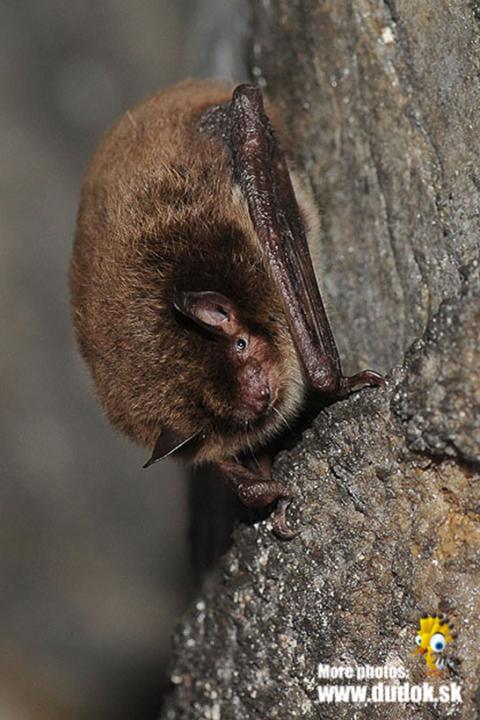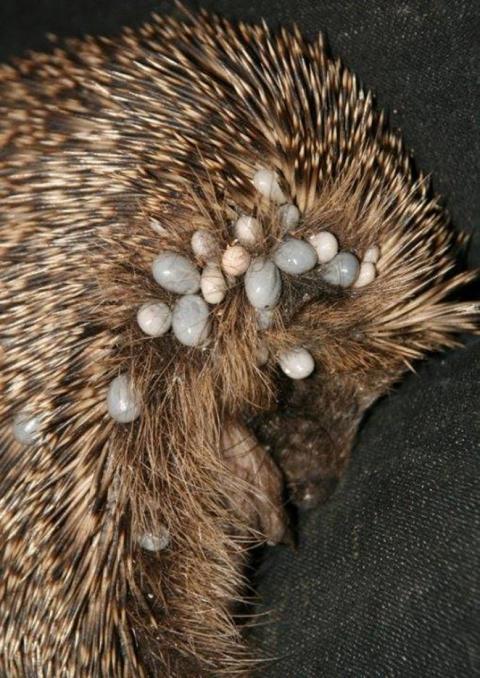Summary
In common with most wild mammals, hedgehogs carry a range of parasites and are susceptible to a number of dieseases of significance to human and livestock health. Perhaps the most significant diseases known in hedgehogs are tuberculosis, foot-and-mouth disease and rabies. There are cases of bovine TB on record, but no spontaneous cases known from the wild, while experimental infection of foot-and-mouth in hedgehogs results in infection and the relatively common paramyxoviruses, which produces symptoms are similar to FMD, seem common in wild hedgehogs in Britain but there are no confirmed cases of transmission from hedgehog to humans. The hedgehog's curious self-anointing behaviour, which includes producing a foaming saliva that is applied to the spines, has been mistaken for rabies in the past, but cases of the virus are very rare in this species and they're not considered a significant vector of the disease.
The details
There are reports of various diseases that are known to pose a health risk to humans and livestock having been identified in hedgehogs. It’s important, however, to maintain a sense of perspective and make the distinction between a potential and an actual carrier for a given parasite or disease. That a hedgehog has been found with a particular disease or parasite does not necessarily mean such an infection is common, or even to be expected, under wild conditions. Nonetheless, hedgehogs have been implicated as potential hosts for several diseases that are important in both public health and economical terms – perhaps the ‘big three’ of these are bovine tuberculosis (bTB), foot-and-mouth disease (FMD) and rabies.
Bovine Tuberculosis
Hedgehogs are known to be susceptible to infection by various species of the TB-causing bacteria Mycobacterium; records exist of M. avium and M. marinum (a marine species!) having been isolated from European hedgehogs, and even successful experimental infection of this hedgehogs with M. leprae, which can cause leprosy in humans. Bovine tuberculosis is a disease caused by the bacteria Mycobacterium bovis. The disease typically manifests with symptoms including a loss of appetite, weakness, weight loss and fever; caseous (looking cheese-like) lesions are also found in the lungs and on the bronchomediastinal lymph nodes, the little ‘filters’ in the neck near the thymus, among other organs. Swelling of the lymph nodes can lead to lameness, especially if it skeletal and synovial lesions occur.

As the name suggest, bTB is typically a disease of cattle -- although other species can contract it -- and outbreaks can have a disastrous impact on farmers at both a local and national level. Figures from the Department of the Environment, Food and Rural Affairs (DEFRA) suggest that about 20,000 cattle are slaughtered annually in the UK after testing positive for M. bovis. While this figure represents a relatively small proportion of the national cattle herd (about 0.2%), it should be noted that culling will often wipe out entire herds and the movement restrictions imposed during outbreaks can mean financial ruin for farmers and associated trades people.
It is widely considered that, in the UK, badgers pose the biggest threat in terms of bTB infection in cattle (see Badgers & TB for more details); in terms of M. bovis transmission, hedgehogs are not generally recognised as a problem species, not least because there is suggestion of a serious decline in this species. Indeed, in his 1994 book Hedgehogs, Nigel Reeve writes:
“Hedgehogs are not significant reservoirs of M. bovis and are less susceptible than rabbits or guinea pigs. Experimental infections with bovis (strain AF117/79) have produced only persistent low-level, low-pathogenicity infections.”
Reeve also notes that, although bTB has been recorded in hedgehogs, there are no records of spontaneous infection of wild hedgehogs. Reeve is referring in particular to a paper published in the Veterinary Record during 1968, in which Sandy Smith presented the case of a hedgehog caught in London’s Regents Park during the early 1930s that tested positive for bTB, which it was thought to have contracted from drinking unpasteurised cow’s milk.
In a 2002 paper to The Veterinary Journal, Richard Delahay and colleagues at the Central Science Laboratory in York and the Veterinary Laboratories Agency reviewed the confirmed cases of M. bovis in mammals from the UK and concluded that cases of M. bovis infection in hedgehogs are rare. Analysis of the 25 carcasses collected during a DEFRA study between 1976 and 1997 failed to find any trace of M. bovis, as did post mortem examinations of 74 individuals collected from Norfolk between 1976 and 1986, and a further 20 carcasses from Berkshire. In a subsequent study, published in the same journal during 2007, Delahay and his colleagues tested 102 hedgehog carcasses for bTB and all were negative.
While cases of M. bovis isolation may be exceptionally rare among the hedgehogs of Britain, infection rates are higher elsewhere; in particular New Zealand. In a short paper to the New Zealand Veterinary Journal during 1995, Ian Lugton and colleagues reported that 5% (4 of 79) of the hedgehog carcasses they examined tested positive for M. bovis. Based on earlier work by Chris Thorns and co-workers published in the British Journal of Experimental Pathology, who established that hedgehogs could be non-lethally infected with M. bovis, Lugton and co. suggested that hedgehogs may pick-up bTB infections while feeding on infected carrion and may then be a reservoir for the disease. Indeed, in her Master’s thesis on tuberculosis in hedgehogs and possums (Trichosurus vulpecula), Robyn Gorton noted that hedgehogs in New Zealand are “spill-over hosts” for M. bovis. In other words, hogs may be able to spread the bacteria; but the disease cannot be sustained within the hedgehog population as it can in, say, the possum or badger population.

Foot-and-Mouth Disease
Foot-and-Mouth Disease (sometimes referred to as Hoof-and-Mouth Disease) is a highly contagious viral disease that predominantly affects cloven hoofed species, especially cattle, pigs, sheep and goats. The virus responsible belongs to the genus Aphtovirus and is part of the Picornaviridae family, which also contains several other important human and animal pathogens; including Hepatovirus, which is the cause of Hepatitis A. FMD is a serious disease of livestock and considerable animal slaughter in conjunction with tight movement restrictions on both humans and livestock are implemented where outbreaks occur. During the 2001 FMD outbreak in Britain some two thousand cases were reported; an estimated 10 million sheep and cattle were slaughtered; and the general election was postponed for a month.
Unfortunately, while human cases of FMD are exceptionally rare, it is not only livestock that are susceptible to the virus. Domesticated animals such as camelids -- camels, llamas, alpacas, etc., the latter of which has grown in popularity in the UK during recent years – as well as various wild and zoo animals, from deer to elephants, are also susceptible. Hedgehogs can contract FMD and although some may be asymptomatic (without any symptoms), the disease seems to manifest as exhibition of dazed, diurnal behaviour along with lesions on the feet, snout and around the mouth (including on the tongue and lips); lesions usually signify fatal infection. A concern for vets and virologists is that hedgehogs may represent an overwintering opportunity for FMD. We now know that experimentally-infected torpid animals don’t excrete viral particles either in their urine or on their breath, like active animals do. In other words, the virus can’t replicate while the hedgehog is in hibernation, but instead it may go into a state of ‘suspended animation’, re-awakening with the hedgehog in the spring to infect clean herds.
It should be mentioned that paramyxoviruses seem common in wild hedgehogs in Britain and the virus’ symptoms are similar to FMD. Paramyxoviruses cause mumps, measles and various respiratory complaints, such as bronchitis and pneumonia, in humans. These viruses can also cause distemper in several mammalian species, including dogs and seals, as well as Newcastle disease in birds. To the best of my knowledge, however, no records of hedgehog to human transmission of paramyxoviruses exist and although hedgehogs have been experimentally infected with Newcastle disease, there are no records of this from wild individuals.
Rabies

Rabies (Latin for “madness”) is an acute infectious viral disease of the nervous system that causes encephalitis; brain swelling. Symptoms include excessive salivation, which contains viral particles, and an aversion to water (hydrophobia), with convolutions and paralysis typically preceding death. The virus responsible is an RNA virus classified within the Rhabdoviridae family, which also contains the bovine ephemeral fever virus and several “yellow” viruses, and the Lyssavirus genus, from the Greek word for “frenzy”.
In their Weekly Epidemiological Record, published in February 2017, the World Health Organization state that, despite great strides having been made in vaccination efforts, rabies still claims and estimated 59,000 human lives per year, mostly in rural areas of Africa and Asia. Vaccination campaigns have been successful in eliminating rabies throughout much of Western Europe, although some European countries (e.g. Germany and Poland) still have a significant terrestrial reservoir of the virus. The last confirmed case of rabies from the UK was in 2002, when a bat worker contracted the virus following being bitten by a Daubenton’s bat (Myotis daubentonii); despite this, the UK has maintained a rabies-free status (i.e. rabies eliminated from the wildlife reservoir) since the 1920s.
According to Nigel Reeve, the hypersalivation witnessed during bouts of self-anointing has often been assumed to be rabies, especially in continental Europe, although verified cases of rabies from hedgehogs are rare. Indeed, in Hedgehogs, Reeve writes:
“… hedgehogs rarely test positive for rabies and are insignificant as vectors, although all species are probably susceptible.”
General malentities
Hedgehogs have also been implicated in several more minor cases of so-called zoonosis; where animals can pass infections or parasites to humans. Hedgehogs are well known to carry a variety of external and internal parasites, including ticks and parasitic worms (see: the main hedgehog article). Transfer of parasites to humans or other animals typically requires direct contact with either the hedgehog or its excretions and, as such, it is no surprise that many cases come from owners of pet hedgehogs; generally, those caring for hedgehogs take the necessary hygiene precautions making such transfer is rare.
In a 2005 paper to the journal Emerging Infectious Diseases, Patricia Riley and Bruno Chomel presented their findings from perhaps the most thorough literature review of hedgehog zoonoses to date. The review covered various different hedgehog species, but, based on the specific cases mentioned, Riley and Chomel list four bacterial (Salmonella spp., Mycobacterium marinum, Coxiella burnetiid and Chlamydia spp.), one protozoal (Toxoplasma gondii, aka toxoplasmosis), one fungal (Trichophyton mentagrophytes var. erinaceid, aka ringworm) and three viral (Bunyaviridae, tickborne encephalitis and Morbillivirus) zoonotic parasites from European hedgehogs. Of these, however, only Salmonella, Mycobacterium marinum and ringworm were confirmed zoonoses; the remainder being “potentially zoonotic”.
Here in the UK, Salmonella and ringworm appear to be the most common zoonoses found in wild hedgehogs. A study by Ian Keymer and colleagues, published in The Veterinary Record during 1991, surveyed the carcasses of 74 hedgehogs recovered between July 1976 and November 1986 in East Anglia, most from Norfolk. The veterinarians isolated S. typhimurium from one individual from one animal and S. enteritidis from another 13. Keymer and his co-workers suggest that Salmonella is common and widespread in hedgehogs in England. They also found ringworm in one animal.

Further afield, two outbreaks of Salmonella typhimurium in Norway, one during 1996 on the island of Jeloy in the east and another during 2000 in the central-west of the country, were linked to human contact with infected hedgehogs. In their study of the outbreaks, published in Epidemiological Infection during 2002, Kjell Handeland and colleagues at the National Veterinary Institute, Norwegian Institute for Public Health and Norwegian School of Veterinary Science isolated Salmonella from hedgehog droppings collected in gardens of infected patients. The virologists also suggest that hedgehog feeding places may serve as sites of Salmonella transmission between animals. Similarly, Birgitte Nauerby and colleagues at the Danish Veterinary Laboratory reported that strains of Salmonella enterica isolated from humans and hedgehogs in Denmark were closely related. In a 2000 paper to the Journal of Clinical Microbiology, Nauerby and her colleagues suggested:
“More than half the patients in this investigation were children who probably often play in outdoor areas where hedgehogs live, and it is possible that the primary source of these salmonella infections arises from hedgehogs, e.g., from contaminated feces.”
Reeve points out that hedgehogs have been experimentally infected with various diseases, including yellow fever and myxomatosis, for which no wild records exist and lists further pathogens that are potentially zoonotic. In Hedgehogs, Reeve’s list includes Escherichia coli, Clostridium perfringes, several Pseudomonas species, Staphylococcus aureus, Yersinia pseudotuberculosis, Rickettsiae (cattle flu) and the Chlamydie bacteria that are thought responsible for the hedgehog’s peculiar folklore of causing bovine abortions.
Hedgehogs have also been found infected with scabies mites. In a 2006 paper to The Veterinary Record, Nikola Pantchev and T. Hofmann report on a case of notoedric mange, infection with the mite Notoedres cati, in an African pygmy hedgehog. The late veterinarian Israel Yeruham and colleagues found sarcoptic mange, infection with Sarcoptes scabiei mite, in western European and long-eared (Hemiechinus auritus) hedgehogs caught at farms in Israel and suggested, in their 1999 paper to Acarologia, that hedgehogs may represent a wildlife reservoir for mange. In a paper to the journal Lutra during 2001, hedgehog carer and former University of Hull biologist Toni Bunnell reported on two western European hedgehogs, a juvenile and an adult, suffering from demodectic mange; this is infection with the mite Demodex canis normally found on dogs and may represent a case of ‘reverse zoonosis’ (see below). Mange zoonosis is well known from other species, biologists contracting scabies from handling foxes, for example, and so cannot be ruled out in hedgehogs.

There are also a variety of lice, worms (Crenosoma, Capillaria, Hymenolepis), flukes (Brachylaemus), protozoa and maggots, which could conceivably pose a very minor risk to human health known from hedgehogs. Many of these parasites were reported by Bunnell in her study of hedgehogs admitted to a wildlife hospital in York between 1998 and 2000. Infection with the nematode worms Crenosoma and Capillaria can lead to verminous pneumonia that, according to a paper by vets Ian Robinson and Andrew Routh in the journal In Practice during 1999, is a common disease of western European hedgehogs and can also infect domestic dogs. Robinson and Routh wrote that:
“Virtually 100 per cent of juvenile hedgehogs presented in the autumn are infected with one or both of these parasites, most exhibiting typical clinical signs of dyspnoea [shortness of breath], coughing, nasal discharge, weakness and emaciation.”
Finally, it is worth mentioning that cases of “reverse zoonosis” are known – this is where a human or domestic animal passes a disease or parasite to a wild animal. In addition to the demodectic mange mentioned earlier, a paper to The Veterinary Record during 1996 by Frederick Widén and three colleagues at the National Veterinary Institute in Sweden reports on the presence of “herpes-like viral particles” in liver cells of a captive European hedgehog that died following several days of distress (characterised by making crying sounds and grinding teeth). The source of this infection was unknown, but in a paper to the Journal of Comparative Pathology during 2002 Neil Allison and colleagues described a fatal herpes infection in a captive African pygmy hedgehog that they suggest originated from the owner, who reported that family members were prone to cold sores (which are caused by the herpes simplex virus).
More recently, in a paper to the journal EcoHealth in 2015, a team from the Zoological Society of London and Public Health England, led by Lydia Franklinos, report on having isolated the Streptococcus pyogenes bacteria from an adult male hedgehog found dead in garden in Northumberland (northern England) during June of the previous year. S. pyogenes is carried by many people and, in most cases, it does no harm; but it can get out of balance and be responsible for a range of conditions from strep throat to streptococcal toxic shock syndrome (the condition that killed Muppets creator Jim Henson in 1990 at the age of 53). Franklinos and her team noticed when they examined the hedgehog that it was in poor condition with severe gum disease and a tooth root abscess, and this, the researchers suggest, is the most likely entry point for the bacteria. They also confirmed that the bacterial infection caused the hedgehog’s death. The researchers concluded that:
“Whilst we cannot exclude that the hedgehog contracted S. pyogenes infection from another (non-human) animal, such as a domestic pet or mastitic cow, the rarity of described non-human infections indicates that this is unlikely. We postulate that infection in this case occurred due to anthroponotic transmission.”
In other words, they consider it most likely that a human passed on the bacteria to this unfortunate hedgehog, where it gained a foot-hold through the tooth abscess. These cases serve as a reminder that people should take basic hygiene precautions when preparing food for hedgehogs visiting their gardens, and that handling hedgehogs without proper hygiene precautions can allow the transfer of parasites both ways.
Overall, as Pat Morris notes in his New Hedgehog Book, European hedgehogs have not been implicated in any major disease transport in Europe; even where their susceptibility to infection has been demonstrated (e.g. in cases of rabies and bTB), their effectiveness as hosts remains undetermined. Moreover, the apparent decline in this species observed across the UK suggests they may play an ever decreasing role in disease transfer to humans and livestock.